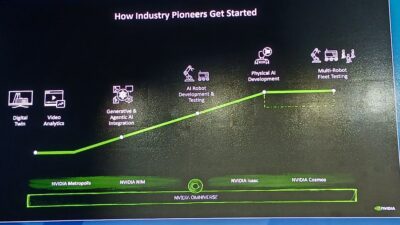The COVID-19 pandemic is creating the opportunity for mobile robots to be used for various markets and could lead to a reassessment of supply chains in the future.

Coronavirus has highlighted use cases for mobile robotics to successfully disinfect, monitor, look over, handle, and deliver materials to the point where the market will grow to $23 billion by 2021, new research showed.
“Crises shift perceptions on what is possible regarding investment and transformative action on the part of both private and government actors,” said Rian Whitton, senior analyst at tech market advisory firm, ABI Research. “By the time the COVID-19 pandemic has passed, robots will be mainstreamed across a range of applications and markets.”
Mobile robots on display
The virus has been a good opportunity for companies to display robots for public applications.
One of the more popular applications has been deploying mobile unmanned platforms with Ultraviolet (UV) light to disinfect facilities. Danish company UVD Robots is reaping the benefits of this opportunity and is scaling up deployments of robots to disinfect hospitals.
U.S.-based Germ Falcon is offering a similar UV disinfection solution for aircraft, while Chinese TMiRob is deploying disinfection robots in Wuhan.
“Automating disinfection is a key part of maintaining health and safety and could be one of the major bright spots in the response to COVID-19,” Whitton said.
Drones have also been deployed to enforce curfews and surveil areas for security purposes.
Short- and long-term opportunities
This represents a big opportunity for aerospace and drone companies to increase sales to government agencies. ABI Research expects the small drone delivery market to reach $414 million by 2021 and $10.4 billion by 2030.
In the short term, to enforce quarantine mandates, governments will need to increase their security apparatuses, as well as the productivity of their medical agencies. Robots will be key to achieving that through disinfection, monitoring, and surveillance. Furthermore, the shutting down of households and even ships represents a chance for robot delivery companies (for both land and air) to display their worth. The drone delivery market could take its experience with transporting supplies in the developing world and scale up their operations in the most affected countries.
Long-term, COVID-19 is leading to a significant reassessment of the global manufacturing supply chain. America’s dependence on Chinese imports for basic equipment and medicines is becoming a contentious issue, and government representatives are already interpreting the crisis as a chance to revitalize the campaign to bring more manufacturing capacity to the domestic market. If this translates into more significant measures by governments to diversify or bringing back the manufacturing of key goods, this could bode very well for the robotics industry, as such changes would require big increases in CAPEX and productivity improvements within developed countries.
COVID-19 represents a disaster for robotics vendors building solutions for developed markets in manufacturing, industry, and the supply chain. But for vendors targeting markets closer to government, such as health, security, and defense, it represents a big opportunity.
Whitton said, “Industrial players develop customized solutions for non-manufacturing use cases or look to build comprehensive solutions for enabling a scale-up in medical supply manufacturing. For mobile robotics vendors and software companies targeting more nascent markets, this represents a big chance to highlight the importance of robotics for dealing with national emergencies, as well as mitigating the economic shock.”
This content originally appeared on ISSSource.com. ISSSource is a CFE Media content partner.



